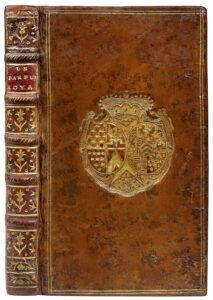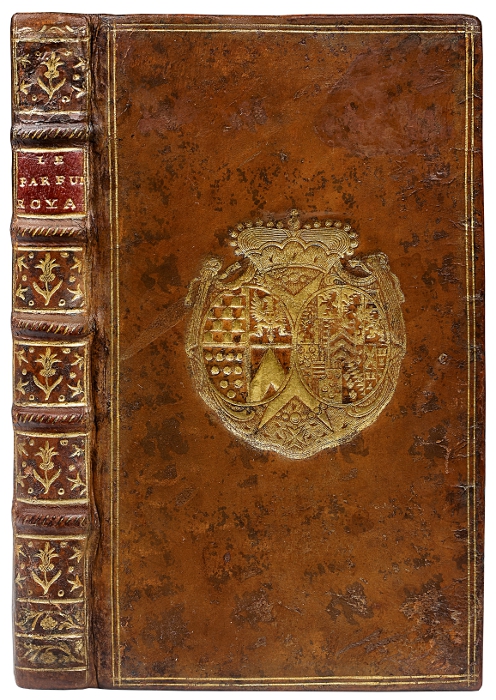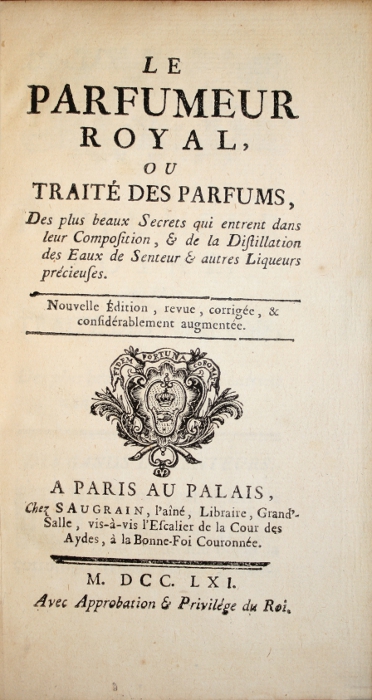A Paris au Palais, chez Saugrain, 1761.
12 mo [163 x 94 mm] of (1) bl.l., (1) title l., 242 pp., (2) ll., (1) bl.l. Small tear without loss in the blank margin p. 75. Bound in full contemporary granite-like calf, triple fillet on the covers, large gilt arms stamped in the center of the covers, spine ribbed and finely decorated, red morocco lettering piece, red edges. Contemporary binding.
Rare edition, corrected and widely enlarged, of this classic of French perfumery.
This famous book starts with the Traité des parfums et des plus beaux secrets qui entrent dans leur composition (pp. -86); followed by the Traité de toutes les différentes sortes de savonnettes (pp. 87 to 105); the Traité des pommades (pp. 106-124); the Traité des poudres pour les cheveux (pp. 125-140); the Traité des grosses poudres de Violette (pp. 141-159); the Traité des eaux de senteurs (pp. 160-174); the Traité des pastille à brûler (pp. 175-179); the Traité des liqueurs à parfums à la bouche (pp. 180-204): we find in this chapter recipes for Ratafias and other liqueurs…; finally the Traité de la distillation (pp. 205-226).
Simon Barbe who was staying in Paris, rue des Gravilliers at la Toison d’Or, was undoubtedly the most famous perfumer of his century. He wrote two perfume manuals, putting down in writing his knowledge and know-how. The first one, Le Parfumeur françois, meant for non professionals in order to teach everyone how to make up perfumes, in particular for “le divertissement de la Noblesse, l’utilité des personnes Religieuses” [“the entertainment of the Nobleness, the use of Religious people”] published in 1693. He wrote in 1699 his second treatise, Le Parfumeur Royal, this time intended for people in the business. He presents this work as useful to “those who pick up flowers and necessary to the glovers, wigmakers and liqueur sellers”. Here, neither a dedication nor a foreword; the author doesn’t flaunt anymore neither the pretension to write for the entertainment of the nobleness, nor for the use of religious people. We feel that the perfume trend ceased. Where did this turnaround come from? They had the misfortune to bother Louis XIV. From then on, it was over for them. ‘Since the King doesn’t like the fragrances, Marana says, everyone finds essential to hate them; ladies pretend to faint at the sight of a flower’.
A precious copy of this perfume treatise contemporary bound with the arms of the princess de Bauffremont (1722-1800).
“Marie-Suzanne-Simone-Fernande de Tenarre, countess de Tenarre-Montmain dutchess of Atry princess de Melfi, countess de Bourlemont, born on August 24th, 1722, inherited the possessions of her house and appointed canoness de Remiremont, Grand Cross hereditary of the Knights of Malta and lady of the Starry Cross; she married, on March 24, 1735, in the castle of Saulcy, Louis de Bauffremont, marquis, then prince de Bourlemont and de Mornay, lieutenant general in the King’s armies, who died in 1769. She remarried in Paris on August 4th, 1777 with Pierre Sainson-Taxis, known as the count de Taxis, and died in Paris on January 18th, 1800, leaving a single daughter”. (Olivier, pl. 2445).



